The rise of prosumers is the latest challenge for marketers
On this page:
- Definition of the prosumer
- The reasons consumers turn into prosumers
- Prosumers – an opportunity for marketers
- How could marketers facilitate prosumption
- 4 steps marketers should take to make the most of prosumption
- Conclusion
As a marketer, it’s your job to know everything there is to know about the people consuming the products for which you are creating marketing campaigns, brand activations and advertising.
They are the consumers.
But who are the prosumers?
Prosumers – definition
Prosumers are the people who produce some of the goods and services entering their own consumption.
The prosumer is not a new concept. In his book, ‘The Third Wave’, futurist and businessman Alvin Toffler predicted the decline of consumers and the rise of prosumers, people who produce many of their own goods and services.
Next year will mark forty years since Toffler published his book in 1980 which means enough time will have passed allowing us to see if his prediction was correct.
Marketing guru Philip Kotler recognized the importance of prosumers for brands and marketers and in 1986 he published an essay in Advances in Consumer Research Volume 13 – ‘The Prosumer Movement: a new challenge for marketers’. In his essay, Kottler builds upon Toffler’s concept of prosumers from a marketing perspective.
Two reasons for consumers becoming prosumers
Instead of purchasing products and services from the market, prosumers can be found making their own clothes, cooking their own food, rearing their own cars and hanging their own wallpaper, says Kotler.
Why do people become prosumers?
Why would they rather produce their own soap than buy one of the many choices the market has to offer?
Kotler identified two reasons: better quality and self-actualization.
Prosumption activities for better quality products/services
Mass production is the manufacture of large quantities of standardized products often using assembly lines or automation technology.
To produce the products, manufacturers are always looking for ways to drive costs down sometimes at the expense of their workers, environment and overall quality of the product.
A lot more care goes into a product prosumers build or produce themselves, from the quality of the materials used to the finishing look. These prosumers care about what goes into the food they eat, the clothes they wear or the detergents they use to wash their children’s clothes.
Hollywood actress and mother of three, Jennifer Garner became increasingly concerned with the quality of food she was feeding her babies.
She began making her own organic, cold-pressed baby food blends. Her blends are free from preservatives, colours, concentrates or added sugars. Just like the food she used to eat when she was a little girl, living on her parents’ farm.
Her company, Once Upon a Farm is a member of the Organic Trade Association and a Certified B Corporation which means the company meets the highest standards of overall social and environmental performance, transparency and accountability.
Read more: 3 successful businesses founded by Hollywood stars
People would favour “make” decisions over “buy” decisions.
Philip Kotler, The Prosumer Movement: a new challenge for marketers
Prosumption activities to achieve self-actualization
Self-actualization means the full realization of one’s creative, intellectual, or social potential.
The concept has been popularized by Maslow in his hierarchy of needs pyramid where self-actualization is the ultimate life goal. Maslow defined self-actualization as follows: “What a man can be, he must be.”
How is prosumption tied to self-actualization?
To answer this question, we must first know what self-actualization is for each person.
Is it becoming a painter? Or taking care of children? Empowering people of all ages to change their lives by acquiring a new set of skills?
Whatever it is, self-actualization is different for everyone.

Agricool co-founders Guillaume and Gonzague / agriculture.gov.fr
French startup Agricool has reinvented the way strawberries are grown and potentially agriculture as an industry.
Co-founders Guillaume and Gonzague came up with the cooltainer, where fruits and vegetables grow vertically.
The cooltainer doesn’t harm the environment, is cost-effective and 100% sustainable. Agricool also created the cooltivator, a new kind of urban farmer. The cooltivator uses the cooltainer to grow their own greens, essentially having a garden in their apartment.
Prosumers – an opportunity for marketers
In his book, Alvin Toffler said prosumerism will usher in the end of marketing.
Philip Kotler has a more positive perspective. Although the increase in prosumption activities means fewer customers for mass-produced goods and services and less consumer interest in brands, he believes marketers should view prosumerism as a challenge and an opportunity for creativity.
Kotler says as follows: “Instead of marketers fighting prosumers, they should look for opportunities to facilitate prosumption activities.”
How could marketers facilitate prosumption:
1. Create better tools. Create better tools for prosumers to use, including better electric power tools for carpentry work, better tools for farming small plots of land, and so on. Agricool is a great example of empowering urban farmers to grow their own food.
2. Simplify the product on the process. “Painting by number” kits allow “Sunday painters” to produce better-looking paintings. “Adhesive wallpaper” allows more people to hang their own wallpaper.
3. Create how-to content. People looking to produce products need to acquire new skills. Think of ways to help them achieve their goals. It could be by providing them with the opportunity to attend evening classes. Or publishing how-to-do content in various formats: text, video or audio.
4 steps marketers should take to make the most of prosumption according to Philip Kotler
- Identify the most popular prosumer activities;
- Think through appropriate product and service responses;
- Direct your promotion appeals to themes stressing individuation, skill-building, and productiveness;
- Develop more specialized messages to reach these highly segmented target markets.
Conclusion
Alvin Toffler’s prediction of the rising prosumers was correct.
Philip Kotler’s prediction of marketers creating messages for highly segmented customers was correct.
He was also accurate when thirty-four years ago he envisioned the increase of how-to content. Today how-to videos are in top four content categories watched by YouTube users next to comedy, music and entertainment/culture.
Creating highly personalized messages is one of Facebook’s recommendations to advertisers looking to increase ad conversions. Being relevant to your customer’s needs is the secret to advertising success.
Relevancy is the word for email marketing also. Email provider MailChimp found that segmented email campaigns perform better than non-segmented campaigns.
One more marketing insight Kotler was right about: people searching for “others with kindred interests, finding them and communicating with them through electronic media”. In the late nineties, people joined discussion forums. When our lives came under the influence of social media, people created Facebook Groups to share information, support and help each other achieve their dreams.
As Philip Kotler says in his essay, prosumers should be looked at as another market segment.
The marketer’s role is to creatively support prosumers achieve their goals.
The aim of marketers should not be to protect the exchange system. The purpose of exchange networks is to facilitate the pursuit of human satisfaction. If the market system is overextended, and if people want to meet more of their own needs, on what grounds should marketers object? The market, after all, is a human invention and it will last as long as it serves human needs.
Philip Kotler
Join the Conversation
We’d love to hear what you have to say.
Get in touch with us on our LinkedIn Group, Facebook Group or Twitter.
These 13 brands use Alexa Skills to engage creatively with their consumers
Is your brand positioned toward consumers? You should consider having an Alexa skill to engage creatively with your consumers.
Why?
Because voice has changed consumer behaviour and brands need to start leveraging its power.
According to eMarketer, voice-control technology has officially moved out of the early-adopter phase and into the mainstream.
The market of voice-assistants (Alexa, Google Duplex, ….) is expanding quickly and the reason is very simple: talking to voice-assistants feels natural to people and it’s more convenient.
Voice-assistants users can multitask and get more done with less friction. Shoppers and parents are power users.
Habitual shoppers love the convenience of the shopping experience and getting things done while taking care of a child is every parent’s dream.
Discover more insights on voice including the 2019 Microsoft Voice Report in How voice is changing customer behaviour and the way you do marketing.
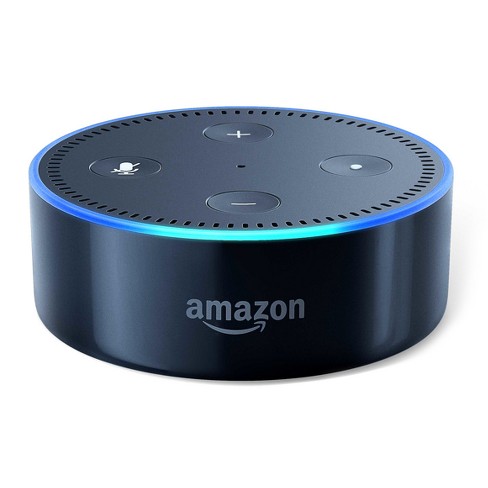
Let’s see how 13 brands take advantage of Alexa Skills to engage with their consumers:
1. Starbucks Reorder
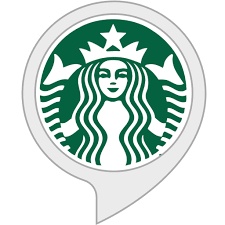
Use Starbucks’ Alexa Skill to reorder your usual cup of coffee from one of the last 10 stores you’ve ordered from.
You can also check your primary Starbucks Card balance and switch between your last 5 previous orders.
2. Domino’s
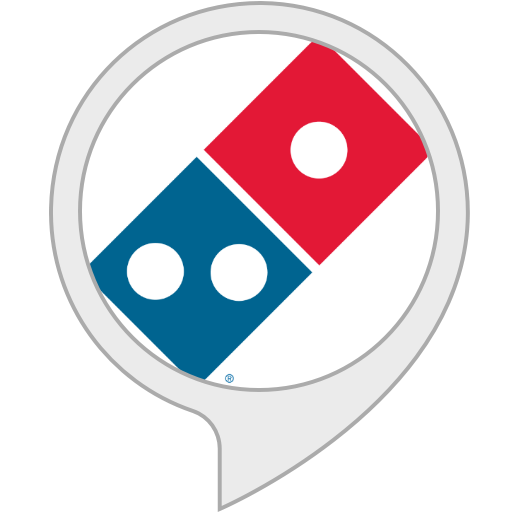
With Domino’s skill, you can build a new order from scratch, place your most recent order or check your order’s status.
3. Uber

Get a reliable ride in minutes with the Uber skill.
4. Citi Entertainment

Citi Entertainment is developed by Citibank, the financial services company. Use this skill to search for thousands of live music events all over the country.
5. TED Talks
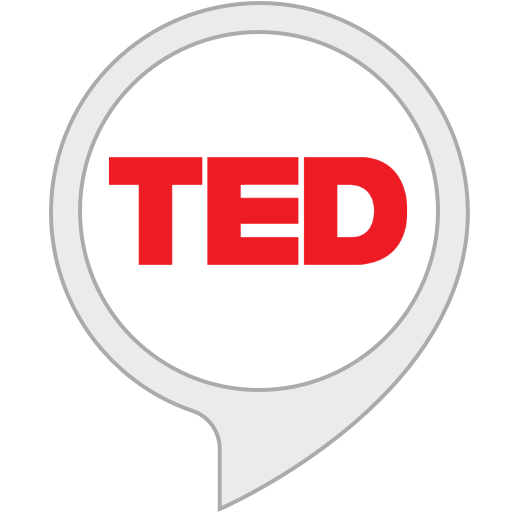
TED Talks are influential videos from expert speakers on education, business, science, technology.
With its Alexa Skill, the nonprofit organization allows users to play the latest TED talk, play random TED talks, or search for talks by topic or by speaker name. They can also play talks that are funny, inspiring, persuasive, courageous, or jaw-dropping.
6. OurGroceries

OurGroceries is a mobile app which provides users with a way to keep grocery lists instantly synchronized on all the smartphones in their household.
This skill lets users add items to the shopping lists on their app.
7. Walmart Stories

In this skill, Walmart invites consumers to discover how the organization is using innovative technologies to redefine the associate and customer experience.
8. Levi’s Assistant
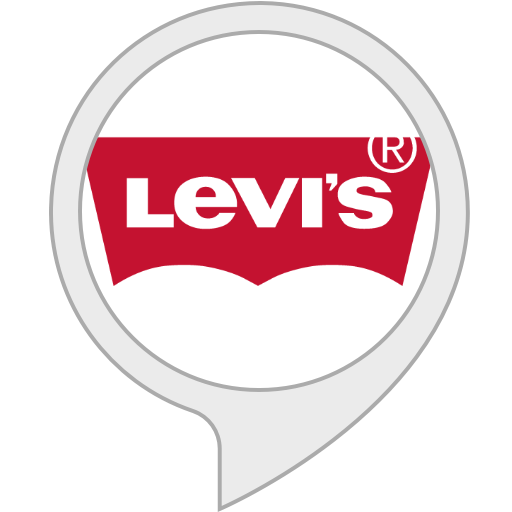
With this Alexa Skill, users get answers to common questions about the jeans manufacturer’s services.
Levi’s shoppers can get help on return policy, how to use gift cards, available payment methods, and more. They can also get help on finding a pair of jeans or the nearest store, track their order and get information on the latest promotions.
9. Bed Bath & Beyond tip of the day

Bed Bath & Beyond Inc. is an American chain of domestic merchandise retail stores.
The company’s Alexa Skill provides users with a daily dose of little life-changers like genius hacks, fun facts, smart tips and expert tricks.
The skill also helps users pick the best products for their whole house, top to bottom.
10. Employment Tips by MooreSuccess Inc.
MooreSuccess is an executive recruiting firm with over 10 years of experience. In its Alexa Skill, the company offers exclusive tips and advice for job seekers from an expert human resources executive.
11. Ten Things in Tech by Business Insider

Business Insider, the financial and business news website operating internationally, developed an Alexa Skill which provides users with the biggest daily tech news.
12. Johnnie Walker

Johnnie Walker, the famous brand of Scotch whiskey goes all-in with its Alexa Skill.
The skill invites users to explore nearly two centuries of whisky knowledge with 4 different options: Choose a Label, Buy a Bottle, Whisky 101, and Try a Guided Tasting.
In “Choose a Label”, consumers can find the perfect blend for themselves or a gift through a series of questions about flavour preference and price.
If consumers are looking to simply buy a bottle of Johnnie Walker, they can choose “Buy a Bottle” and Alexa will help them find the nearest store or delivery option.
When they select “Whisky 101”, Alexa will share a random fact about Johnnie Walker or whisky in general.
In order to “Try a Guided Tasting”, consumers will need one of the core Johnnie Walker Labels on hand: Red Label, Black Label, etc. Then, Alexa will conduct a personalized tasting based on the blend they choose. As they sniff and sip their way through the tasting, she’ll give helpful tips and ways to serve.
13. Hellmann’s Best Recipes by Unilever

Hellmann’s Best Recipes by Unilever is the perfect answer when you want to cook your family a hot meal and need some culinary inspiration. Hellmann’s Alexa Skill has got you covered with a large database of delicious recipes. It’s too late to go shopping and you need to cook with whatever ingredients you have in your fridge? Hellmann’s Best Recipes can help you by providing recipe ideas for ingredients you already have on hand.
Are you planning to launch your own Alexa Skill?
Good!
To make sure you treat your consumers to a great voice-activated experience, here’s how your skill needs to be:
![]() Frictionless. Make sure your users’ experience is seamless.
Frictionless. Make sure your users’ experience is seamless.
![]() Helpful and informative. Include answers that your customers might look for: discounts, catalogue prices, return policy, work hours, the closest store, recommendations related to your product etc.
Helpful and informative. Include answers that your customers might look for: discounts, catalogue prices, return policy, work hours, the closest store, recommendations related to your product etc.
![]() No commercials. Refrain from including commercials in your skill, it’s annoying and it turns people off.
No commercials. Refrain from including commercials in your skill, it’s annoying and it turns people off.
![]() The latest. Provide your consumers with the latest news, the latest company info or products discounts. If you are providing news like the Business Insider, ensure that you upload the latest relevant news to your users.
The latest. Provide your consumers with the latest news, the latest company info or products discounts. If you are providing news like the Business Insider, ensure that you upload the latest relevant news to your users.
![]() Entertaining. If it’s aligned with your brand values and consistent with your brand voice, be entertaining.
Entertaining. If it’s aligned with your brand values and consistent with your brand voice, be entertaining.
![]() Helpful. Help users complete a task or guide them through the stages of a process (cooking a meal etc). Also, cater to your consumers’ needs even if this means not recommending your own product. Hellmann’s skill has a large database of recipes with and without mayo.
Helpful. Help users complete a task or guide them through the stages of a process (cooking a meal etc). Also, cater to your consumers’ needs even if this means not recommending your own product. Hellmann’s skill has a large database of recipes with and without mayo.
![]() Keep the conversation going. Find creative ways to keep talking to your consumers on other platforms (email, social media) and turn them into brand ambassadors.
Keep the conversation going. Find creative ways to keep talking to your consumers on other platforms (email, social media) and turn them into brand ambassadors.
Have you found this article useful?
Share it with your colleagues!
Nvidia – Blurring the Lines Between Virtual Reality and Real Life
Blurring the lines between real life and virtual reality has never seem so close and possible. Nvidia combines its Virtual Reality Holodeck application with Self Driving Cars, in order for a human to be able to take over a vehicle remotely, in the event of a problem.
According to TechCrunch, the driver was sitting on the stage of the convention center wearing an HTC Vive and seated in a cockpit-like car with a steering wheel. Using Nvidia’s Holodeck software, a car was loaded. Then, a video feed appeared showing a Ford Fusion behind the convention center. The driver in VR had seemingly complete control over the vehicle and managed to drive it, live but slowly, around a private lot. He navigated around a van, drove a few hundred feet and parked the car. The car was empty the whole time.
Inside the simulation, users could grab the car’s steering wheel, or watch it explode into its component parts. According to VentureBeat, the Holodeck will be available more widely as a demo in September.
Moreover, according to enterprisetech.com, Nvidia revealed how it’s planning to use virtual reality technology to accelerate the testing of autonomous vehicles. The new offering, called Drive Constellation, could dramatically improve the capability to test certain driving conditions, such as snow or blinding light, that can be hard to get in the real world.
Nvidia will use Drive Constellation offering to scale up the testing of the algorithms that autonomous vehicles use to make decisions. The solution, which is expected to be available in the third quarter, will combine two main products.
The first component in Drive Constellation will be the company’s Nvidia Drive Sim software, which simulates the data emitted from sensors used in an autonomous vehicle (AV), including visual cameras, thermal cameras, radar, and LIDAR. The second component will be Nvidia Drive Pegasus, the GPU-powered computer that actually processes the AV’s sensor data in real time.
Together, the components will allow Nvidia customers, such as Google and Uber, to significantly ramp up the number of miles driven in cyberspace before putting the AV on the road for a real-world test.
Contextual editorial video content in a video intelligence connected world
Contextual editorial video content dramatically increases a consumer’s engagement and recollection of video advertising on a web page, showed a new study about video intelligence, conducted by Lumen Research. The findings show an increase in dwell time by a third and improves user perception of publisher platforms by 9%.
In the study took part 200 consumers that were asked to share opinions on commercial and editorial content on an entertainment site, looking at engagement, dwell time and perception – both with and without contextual content. Respondents were invited to download Lumen’s software onto their laptop computers, which temporarily turns their computer’s webcam into an eye tracking camera. The participants eye movements were monitored to understand what they looked at – and what they ignored.
The findings showed an overwhelmingly positive reaction from when users are presented with contextual video content instead of standard advertising, or out-of-context video. Contextual content was shown to increase dwell time on the page by 33% – from 33 seconds to 47. The placement of video intelligence contextual content also saw an increase in the attention users paid to accompanying advertising, with 71% of respondents engaging with pre-roll video when viewed alongside contextual content, compared to just 50% when viewed without. Recollection of pre-roll was also increased as a result of the page featuring coherent contextual content.
Perception of publisher sites is improved with contextual video as a result of increased attention and engagement with content across the page. 85% of respondents described the page as engaging when viewed with contextual video (78% without), and 80% thought the entertainment site had ‘was enjoyable to browse’ when viewed with contextual video (69% without).
“We already knew contextual editorial content dramatically improves user engagement with advertising content, but to see that it improves engagement with other ad-content and native editorial content is fascinating. At video intelligence we’re dedicated to helping publishers deliver great user experiences, and we’re pleased to see that vi stories delivers a strong halo effect for both brand and publisher,” said Kai Henniges, CEO and co-founder of video intelligence.
On his turn, Mike Follett, managing director of Lumen Research, added that, because contextual content like video intelligence stories is more relevant and interesting than typical digital videos, people are willing to spend time with the accompanying advertising to see it, demonstrating that video intelligence stories makes both native content and non-contextual advertising on the same page more memorable. Attention matters – and vi drives attention.
vi stories allows publishers to embed a native video player on their platform that matches the look, style and design of their app or website. A natural language machine learning algorithm, powered by IBM Watson, finds and serves editorial video based on its analysis of the page content. Content is sourced from a vast and continually updating video library, containing clips from outlets like ITN, Bonnier and Euronews.

The product aims to create highly engaging experiences for users and increase the time they spend on the site, creating greater monetisation opportunities on publisher platforms. vi stories inserts advertising within the player, allowing advertisers to target engaged viewers with audience-appropriate branded content in a native media environment.
The research saw participants read an article on an entertainment website about the Oscars, half with contextually relevant video content and half without. The same ad for M&Ms ran before both videos. Having read the article and had the chance to watch the video, respondents were asked to complete a short questionnaire to assess their recall and perception of the ads they had seen and their perceptions of the publisher site. The respondents were paid for their time, and the software deleted from their machines as soon as the test was completed.
vi is a contextual video platform, connecting publishers, content providers and brands through video storytelling. Video inventory is lacking, and users are hard to captivate, therefor vi’s tools use contextual matching to create compelling video experiences on desktop and mobile. vi offers a full suite of self-serve tools: a video syndication engine powered by machine learning, a video ad server and an SSP. vi is trusted by 20,000 publishers to deliver millions of contextual video stories every day.
How To Create The Right Niche Positioning Strategy
Niche marketing is a targeted marketing plan that focuses on one particular section of the market that has high potential to connect with a product or service. Instead of casting a wide net in mass-media and large-event marketing, niche marketing zeroes in on strategically selected venues and media platforms that have high concentrations of these targeted consumers.
Niche Marketing Strategies (according to marketing-schools.org):
- Word-of-Mouth Campaigns: These campaigns rely more on conversations among consumers than advertising or marketing materials touting the product or service. Brand exposure is low key and subtle, such as sponsorship or giveaways at events or establishments frequented by the niche market. As a result, these campaigns take longer to develop and yield results, but the returns can be extremely high, given that word-of-mouth recommendations generally carry a lot of weight with consumers.
- Trusted-Messenger/Endorsement Campaigns: This strategy hinges on finding a few key influencers in the niche market and enlisting them as spokespersons on behalf of a product or service. An example of this strategy would to hire Wilford Brimley (a longtime actor who is known and loved by many senior citizens) as spokesperson for medical products used frequently by the elderly. The success of these campaigns is highly contingent on the credibility of the spokesperson and the sincerity with which the endorsement is delivered.
- Targeted Collateral Campaigns: This strategy relies on consistent brand exposure to the targeted Niche Market. Just about any radio station that plays a niche type of music (alternative, country & western, or classical, for example) that appeals to a certain audience will employ targeted collateral campaigns. They might distribute collateral and attend concerts by artists played frequently on their station, or advertise in local music/entertainment publications.
Choosing your niche positioning is one of the hardest decisions a business can take, as the dimension of the market you are entering on is very important.
Evaluate your target markets under several criteria. First and foremost, define and size the market. If it’s too broad, it’s not really a niche. If it’s too small, you will plateau very quickly. At the same time, examine the barriers to entry. If anyone can enter the market, it will be very hard to sustain a competitive advantage. Select niches that require an investment, both in time and dollars, because that will keep others out. – stickybranding.com
More that than, the niche chosen should take the account the field you are specialized on and have the best expertize to offer to your consumers. Your ability to service your niche and create sustained competitive advantage will come from your operations versus marketing. When customers seek out a specialist they have high expectations. And your business and services must reflect that reality.
Positioning involves also the followings taken steps: identifying the organisation’s or brands possible competitive advantage, deciding on those that are to be emphasized and implementing the positioning concept.
At the same time, don’t forget about the key factors that make you and your brand/company special and different on the market. They must always be in top of your communication and strategy plan.
5 pieces of advice for entrepreneurs in 2018, the media agency point of view
Having the right media mix and campaigns represents a very important moment in a company’s marketing strategy. Choosing the right track might be hard to find, therefore every business needs a good media consultant. A point of view written by Razvan Varabiescu – CEO Dentsu Aegis Network Romania.

- Disrupt Or You Will Be Disrupted.
In a digital economy you have to look at things as a start up or as a business turnaround. If in the past because of the volume of media budgets one could afford to “ignore” the small competitors who due to the financial entry barrier did not afford big reach on TV or other kind of exposures, today, regardless if you are a startup or a 20-year market leader, one can not ignore the new environments, the opportunities that appear, you have to be forever ready to disrupt and to think things like a start up.
- Content Is King
Today, the consumer has an overwhelming number of options on how to consume media. Whether we are talking about digital radio or analogue TV or live vs. registered by Netflix, Amazon Prime, HBO Go, YouTube etc., it is very important to integrate the product into the content. The environments are evolving and it is increasingly difficult to predict where and how consumers consume media. However, it is certain that the relevant content for them is different, so the big players continue to invest permanently in premium and unique content. The more we manage to integrate the media into the content, the more we make sure that we will not be ignored.
- Data Is The New Currency
Everybody talks about our data. However, data collection is still at the beginning. 92% of the data we have today is gathered over the past 2 years and probably the trend will continue. It is still not too late to collect data on our consumers. Why? This is simple: in the future when all the media acquisition is done programmatically, the data we have will make the difference. Imagine a world where the cost per thousand is given by supply and demand, the difference being made by how many consumers I need to reach to meet my marketing goals, sales, etc.; the most effective campaign will be the one that achieves its goals by reaching as few people as possible by getting in contact with those who are willing to act. But how do we figure out who they are? Using the data, obviously.
- Strategic Thinking At The Core
As media moves towards programmatic, the price pressure will drop and a relevant and different strategy will make a difference. If in the past we were all strategists and we had strategies for media, PR, BTL, communication, marketing, etc. all today’s touchpoints are interconnected and need to have a single strategy able to deliver in all communication disciplines. We cannot have a TV campaign anymore and pray that someone writes a post on a blog about the product, we cannot pay 2 bloggers hoping to get the story. Things must be thought from the beginning, interconnected, measured. The strategy will make the difference exactly as low prices on TV was the law.
- Attract The Right Talents
This is probably another cliché. But we have to realize that the Y generation is the generation that will provide the main workforce for the next 20 years. 54% of companies will work with online workforce over the next 5 years. It’s the savvy digital generation. Every hour a car replaces the work of a man. The main problem we have in the coming years is to succeed in attracting and securing talent in the organization. For this, every manager should ask himself how can he change organizational culture to adapt to the new needs of the millennial generation. Let’s not forget we’re talking about a sensitive generation called the Snowflake Generation.
How Luxury Marketing Will Look Like in 2018
The concept of luxury is changing, just like everything we are surrounded by is, like our preferences and sometimes passions. Consumer expectations of luxury continue to rise, and that what used to be luxury is now seen by the current generation of consumers, everyday experiences. And, as always, technology has a big part in this change as it makes everything easier,closer and more affordable, therefore what some years ago was considered luxury today might not be so. And just like what today is luxury in the years to come might not be anymore. The definition of luxury is changing, while “upper luxury” appears.
According to Deloitte’s “Global Powers of Luxury Goods 2018”, the world’s 100 largest luxury goods companies generated sales of US$217 billion in FY2016 and the average luxury goods annual sales for Top 100 companies is now US$2.2 billion. The report discusses the trends and issues that are driving the luxury industry. It also identifies the 100 largest luxury goods companies based on publicly available data for FY2016 (which they define as financial years ending within the 12 months to June 2017), and evaluates their performance across geographies and product sectors.
The growing importance of non-western markets for the luxury goods industry has been supported by supply chain leadership, technological innovation and international investment. These factors will help maintain further strong
growth in these geographical markets.
Deloitte’s “Global Powers of Luxury Goods 2018” points out:
Luxury brands have refocused their business strategies to capitalise on these changes. Giorgio Armani is engaged in an in-store installation collaboration agreement with Colombian artist Marta Luz Gutiérrez, while Louis Vuitton is conducting an advertising campaign using a
building designed by the late Mexican architect Luis Barragán. Rising prosperity in major cities and growing formal market power over the black market will ensure sustained Rest of the World (ROW) demand for luxury goods. To succeed in this context, luxury players should focus their investments on digital connectivity, upwardly mobile consumers and bold business models, which are key components of the
personal luxury industry today.
Some aspects that marketers must pay attention and act on in 2018:
Still according to Deloitte, collectively, Millennials and Generation Z will represent more than 40 per cent of the overall luxury goods market
by 2025, compared with around 30 per cent in 2016. Unlike Baby Boomers, many Millennial luxury consumers expect to interact with brands across a range of digital platforms, rather than only through traditional channels. Millennial consumers are also important for in-store shopping and expect a high-value, customized experience. Luxury brands should seek to change their business models to meet this demand, for example by providing more loyalty
programs and invitations to in-store events.
Customize your approach according to your audience. Personalization is still key as a marketing technique to be used as 45% of luxury consumers are asking for personalized products and services. With different expectations, younger
shoppers seek a personalized shopping experience that seamlessly integrates both online and offline platforms. This shift has motivated demand for connective technology such as Augmented Reality (AR) and Artificial Intelligence
(AI). By using AR and AI technologies, luxury brands can provide a personalized consumer experience, reach a wider audience, deepen product experience, and build stronger customer relationships. In parallel, the development of technologies such as voice commerce and the Internet of Things (IoT) are reshaping the entire luxury industry.
Luxury brands positioned as reliable sources of AI-driven recommendations are improving how they engage with consumers. More widespread adoption of AI is also making consumers increasingly reliant on suggestions and advice
provided by their various devices, rather than making decisions based on personal experience.
Social media becomes an important marketing tool for luxury as well. Instagram became the leading social media platform for fashion designers. Gucci more than doubled its Instagram followers between 2016 and March 2018, with successful Insta-campaigns such as #TFWGucci.
In future, the biggest challenge for luxury brands will be to make optimum use of social media without compromising their brand values. The success of a social media strategy will be converting “likes” into an interactive and engaging experience for customers.- Deloitte
An omnichannel approach – onnichannelluxury
A true omnichannel global market environment would require luxury brands to close gaps in customer experiences across channels, to offer a seamless, unified brand experience irrespective of the device or physical touchpoint used. Therefore, each channel needs to interact with and support
others to establish a single brand presence. Demand for an omnichannel approach is a natural development from the spread of digital technology and
e-commerce markets. During this process of change, the ability of luxury brands to leverage available inventory will be a key differentiator.
Digital must remain a priority to define an omnichannel strategy compatible with target expectations. The percentage of online sales perceived as being additional, and not a cannibalization of, physical sales is decreasing each year, with China the least cannibalized country to date.
“Luxury brands should develop their mobile strategy: 55% of luxury consumers buying online use their mobile phones versus personal computers. Peaks appear among the youngest generations and Chinese consumers, 75% and 77%, respectively, of whom use mobile. Social media and influencers are gaining power. For the first time, social media is the first source of information and the channel of primary impact used by true-luxury consumers, followed by magazines and brand websites. Five platforms (Facebook, Instagram, WeChat, Weibo, and QQ) are dominating the social media world, but Facebook is losing momentum to Instagram in the Western world and QQ is losing momentum to WeChat and Weibo in China,” states in “True-Luxury Global Consumer Insight”, the fifth edition of an annual study by The Boston Consulting Group (BCG) and Altagamma.
Millennials: Consumer Aspirations Are Disrupting Luxury
Collaborations with streetwear brands and artists are becoming the norm for Generation Zers and Millennials. “Collaboration covers demand for newness in a less risky way. It gives brands a cool edge and strengthens brand awareness as well as increases willingness to buy the brand. Collaboration is increasingly in demand and turns out to be a very effective purchasing incentive,” said Olivier Abtan, a partner in BCG’s Paris office and the global leader of the firm’s luxury, fashion, and beauty topic.
Unlike “absolute luxurers,” who buy luxury items exclusively, millennials do not hesitate to mix and match. According to BCG’s study, about 55% of this group trades down to buy handbags or T-shirts from cheaper brands, or mixes their style by buying sneakers and luxury shoes from luxury niche brands (including luxury sports). This trend appears to fulfill consumers’ need to create their own style. When they do look for different brands, it’s because luxury brands don’t have offerings in certain categories or because of the Millennials’ desire to have a unique style, express themselves, and seek out niche brands.
Use iconic personalities in your communication
With all the big changes, some things are meant to last and take the test of time. Chanel’s iconic marketing history began with a print advertisement for its perfume, Chanel No.5, in 1921. Its first celebrity endorsement didn’t feature until 1954, with Marilyn Monroe. However, it wasn’t until 2005 when Chanel first adopted videography, and from here, the rest is history.
“Despite not adopting social media and integrating the platform with videography until 2009, its marketing strategy is nothing short of stupendous. Selecting admirable public figures such as Keira Knightley and Nicole Kidman to star in Chanel’s unmistakable short films, revived the brand as an iconic symbol of both cultural and digital relevance. With the use of video and social media integration, Chanel has grown to having more than 57 million social followers globally, the highest in the luxury fashion industry. The brand focused on Facebook as their initial social media platform, due to the video capabilities such as extended video length, that Twitter and Instagram do not support. For the brand’s primary consumer, the more wealthy and mature client, Facebook was the ideal platform for accessing this demographic,” wrote Little Agency.
Sensory Branding
According to Retail Insider, British Airways is encashing big on a recent study on sensory sciences by Oxford about how sound influences the taste of food. Based on the findings of this study, they launched a list of 13 in-flight tracks to enhance the taste of the meals served during the flight, providing a truly luxurious experience. Moreover, Soundwich in Portugal delivered gourmet sandwiches packed in metal boxes that play music chosen by the chef when opened.
More ideas you can see here.
The Virtual Promoter and why use it in your campaigns
Sometimes is hard to keep up with the technology at the level that is evolving, but by doing it you make sure your business stays in front of the pack and continues to gets more and more loyal customers. In this context, the retail industry has become one of the most competitive and dynamic areas of work, with brands literary fighting for the top stops in consumers’ minds.
It’s time for the agencies be even closer to their clients and help them reach their business goal. In retail, virtual mannequins have become an ideal, interactive display to inform customers, visitors and guests. The virtual mannequin can be you, a member of your staff or a hired actor. Virtual Mannequins create a ‘hologram model’ that enables stores and brands to display consistently powerful and engaging sales pitches, promotional and informational messages. Virtual promoter can be used in shopping malls, supermarkets, banks, airports, auto-dealerships, hotels, restaurants and a host of other areas.
efmp (European Field Marketing Partners)’s agencies in the Czech Republic, Germany and Romania are some of the few agencies in the world using this state of the art interactive 83” rear-projection media display platform, called the Virtual Promoter. This platform has been designed to produce a life-size display that interacts by gestures and hi-fi sound feedback.
“The interactive displays are aesthetically pleasing and effortlessly catch the attention of the passing consumers. The engaging nature of the displays makes consumers curious and encourages them to explore the technology; as a result every detail of the product is promoted. Whether it’s product information, special offers, services or long-term customer retention, there is no better way to capture the attention of the customers at the point of sale (POS); and the virtual promoters are always on duty,” wrote efmp on its blog.
Due to the novel way that virtual promoters display information, consumers are receptive to far more information. This is a great advantage for brands operating in a competitive environment. However, the benefits go beyond just engagement but also include the recording of in-depth customer metrics, with smart data giving brands insight into their target audience.
PPM Factum in the Czech Republic is one of only a few agencies in the world to use this progressive technology. They launched their virtual promoter (ViP) at the Retail Summit on 1st February 2016. According to its website, it is a device designed by the company Ameria, Germany, and is based on the motion capture. The Virtual Promoter (ViP) offers to show your advertisements or product range in a completely new and original way. By means of creative and entertaining application formats it is possible to communicate via the ViP much larger amount of information, moreover in a absolutely non-aggressive way, which is perceived very positively by customers.
“The essence of using this technology is to give brands a deeper understanding of how customers experience them in the retail environment, which in turn enhances their business intelligence and allows them to make strategic changes to implement cost savings and an increase in sales. It allows our agencies to translate their activities into data that shapes business decisions. Given the variety of campaigns delivered and the objectives for each, all agencies are able to create and report on bespoke metrics that are tailored to an individual brand’s needs. The ultimate objective is to optimize performance. A variety of platforms and tools are used to deliver campaigns; below we outline some of the outputs and benefits of this technology,” added efmp.
Some of the advantages for the business are:
Increase attractiveness of your business place. Attract attention to your shop.
Call to action. Process promotions & novelties and attract customers to your shop.
Information and navigation function. Offer information on your products including navigation through your business location.
An assistant support. Provide service outside your opening hours or unburden your sales assistants during peak hours.
Entertaining function. Offer your customers a pleasant use of time while waiting, kid´s corner.
CRM innovation.
Quality evaluation of promo event effectiveness based on accurate data.
Attracts attention of passersby by addressing them proactively.
Promo function is accomplished unobtrusively in the background by providing information or via an entertaining application.
“GIMMO Virtual Promoter” (ViP) is a device working on the principle of a projection on a glass coated with special foil. The glass can be placed in space or in a shop window. The device is equipped with the most advanced motion sensor that can recognize and contact passersby. It responds to gestures and sounds; creates an illusion of a real person. Moreover, still according to its website, almost 7 % of passersby stop and watch on average of 40 seconds, 2 % of passersby proactively test the device and spend on average 70 seconds on it. The device keeps customers´ attention much longer than any other type of media. Percentage of expressed interest is significantly higher than in other measurable media (internet).
Top trends in shopper marketing in 2018
With a more and more savvy consumer and digital and technology re-shaping it, shopper marketing became in the last years almost a science, relying a lot on research and customer observation. While in the US, the Shopper Marketing magazine developed a very strong research on this year’s trends that can be read here, we asked 3 local advertising specialists to give us their thoughts as well.

Cristina Oncescu, Head of Strategy pastel
What do you believe will be the biggest shopper marketing trends of 2018?
I don’t know if they are the biggest, but they are certainly hot in 2018:
- Personalised shopping
There are many in-store technologies that can be used to provide a personalised shopping experience. NFC (Near Field Communication) chips, QR codes, iBeacons and Visual Light Communications are just some of the emerging technologies used. These, when linked to previous shopping histories via a loyalty app for instance, can provide disruptive yet compelling interactions with the shopper as they enter the store.
- Virtual assistance
From voice to chatbots, going through messenger apps, one-to-one communication is on the rise. Being available and being helpful, when the shopper needs you, is making the difference.
- Augmented Reality
The use of Augmented Reality on mobile devices provides an engaging way for marketers to reach their target audience – it’s quick, easy and very interactive. With the integration of AR on iPhones, it will be easier for marketers to engage larger audiences during their path to purchase.
What are they influenced by and why?
Technology, and especially mobile, led shoppers becoming more and more omnichannel. Now, this is an actual behaviour that the shoppers engage in (of course in a subconscious way). Web, mobile, social, apps – it’s all just shopping to consumers. The separation between retail channels is growing even more blurred by the day. Can they return online products in-store? Can they check if the store has their size and colour on their mobile phone before they leave their homes? Consumers expect a seamless experience across all channels.
What is pastel advising its clients this year?
Great content will always engage. Have an interesting, consistent story and a seamless experience throughout the whole omnichannel path to purchase.

Anton Gherca, Chief Innovation Officer at g7
What do you believe will be the biggest shopper marketing trends of 2018?
We believe that shopper marketing is an area of brand communication that has been kept largely untouched by the digital revolution that is reshaping the advertising industry for the past 10 years. So we expect that „digital BTL” will start gaining momentum, as today’s practices are deeply engrained in traditional approaches of point of sale communication. We think that we will see more connections between social media and shopper marketing, and geofencing and point of sale promotions, with the aim of delivering a more integrated omnichanel shopper experience.
What are they influenced by and why?
Like many things in advertising, the move towards a more „digital” shopper marketing approach is driven by the consumers themselves, or more precisely, by their lifestyle. As of 2017, the penetration rate of smartphones in Romania is 70%, while 41% of the population are already mobile social users. Peer-to-peer ridesharing like Uber makes people understand the benefits of the sharing economy, on-demand services like Netflix put them in the driver’s seat while the wide 4G coverage makes them want everything now. This means people are getting more and more accustomed to having everything at a push of a button and they expect higher levels of service, increased transparency, embedded interactivity and all in all a better customer experience out of everything.
I know this sounds like a bunch of buzzwords cramped togheter in one sentence, and our agency has never been in the „buzz” business, but the reality is that the shift in consumers’ lives is happening with or without us. I think the bottom line is that today’s shoppers are just expecting something more out of marketing communications. More relevance, more engagement, more customization. This doesn’t mean that we, the shopper marketers, can’t still get away with the old „buy one – get one” or „scratch this to win a prize that you don’t even want” mechanics. But wouldn’t that be a pity?
What is g7 advising its clients this year?
Our agency has embarked in a digital transformation journey and once set in motion, it can’t be stopped. We will continue an initiative started in 2017, of hosting periodic innovation workshops together with our clients for identifying the opportunities put forth by today’s technology, and see where that gets us. Still, there are a couple of areas we keep tightly in our focus: Proximity marketing, Loyalty management and Gamification. We work towards integrating in an organic manner these three capabilities in the approach our clients are already used to: honest creative work, deep understanding of shopper behavior and solid deployment in the retail ecosystem.

Ondina Olariu, Business Director Geometry Global
“Fragmentation, increased competition and e-commerce are key words for 2018 and beyond in our region. After seeing a huge expansion, somewhat even inflated for some of the retail players, we will witness a new battleground, named proximity. As global retailers keep expanding, we will live through a great variety of formats, more flexibility and adaptation to micro-retailing needs. Proximity will be influenced as well by the increasing degree of urbanization, as well as the new generations of shoppers, more dynamic, digital savvy and format switchers (in Romania, 25 cities cover 31.3% of total population and 55.6% of urban population – source: INS, Romania, 2017).
And when we say flexibility and adaptation, think beyond format, as we see discounters aggressively stepping in the services territory, while share of consumer spend reached 68% in services vs 32% in goods in 2016 (source: Kantar Global Trends 2018). Goods subscription – meaning bundle goods as a service is something that we preached our clients for a couple of years already and it’s approaching it’s turning point in 2018.
E-commerce in Europe is predicted to reach 10% of total retail (source: Kantar 2018 Global Predictions, WPP Data), with a clear future towards what we call omni-channel, especially since gen Z takes the scene as newest shoppers. At global level we see the switch and struggle of most pure e-commerce players in becoming physical as well, to the level where blogs impersonate the physical space in temporary shops where experience blends with sales, while in Europe we are taking steps into developing the brick-and-mortar into e-commerce, especially for FMCG area, which are the most shopped for categories. Retailers will continue or start monetizing opportunities through their own apps, following the evolution of more mature markets, such as Spain (+210% in app sessions growth in the last 2 years) or Germany (+130%). Here again, it seems that pure digital players have a degree of advancement, since digital-first retail apps saw more that 2x the average sessions / user each month and saw stronger growth in the last 2 years. (source: App Annie 2017 retrospective report). This means we will see accelerated growth for digital players apps, as the new arrivals from physical retailers will need to extract good lessons and apply on fast track.
Blending online and offline expresses also in automation, such as automated cashiers. As retailers will increasingly see value, watch for a retail unemployment crisis, especially in more mature markets. The proliferation of private labels will increasingly force out brands from the physical shelf. Most of these private labels continue to be supported as brands rather than price options, from food to fashion (see Esmara for Lidl and Tex for Carrefour) and home appliances (eg Carrefour Home consumer electronics). Health and Wellness is an increasingly appealing theme, for both brands and retailers. Watch the shelf space growth in store, as well as the latest positioning of certain private labels, trying to capture value and exploit the trend.
As a shopper agency, we are not only advising but already working with our clients on the omni-channel shopper journey models, including retailer strategies and new channels opportunities in this process. We build with them strong e-commerce fundamentals for the Romanian market and expand to e-commerce experiences and integration of channels for more mature markets. We operate with an increasingly complex model that includes data management and A/B testing applied to shopper initiatives and integrate thorough shopper knowledge in every solution we bring to the table. Bonus: an emerging trend, still less visible to this market is the return to D2C (Direct to Consumer). It will be highly influenced by retailers’ behavior, however, more brands become conscious they cannot rely exclusively on retailers and distributors in building their relationship with shoppers and consumers, therefore they’ll be trying to find ways to cut it short to them and bypass the “official” channels.”
Are “micro-influencers” relevant for your marketing strategy?
After the era of influencers, the end of 2017 and all of 2018 seems to be heading on the trend on micro-influencers. Even the micro influencer may only have a few thousand followers, what they lack in numbers they make up for in their ability to maintain authenticity. They engage with their audience with honest product reviews and purchase recommendations.
The number of social media users worldwide is expected to reach 2.77 billion in 2019. Social influencers provide a return on investment of $6.50 for every $1 spent by businesses. Moreover, influencer marketing generates 11X higher ROI than traditional forms of advertising each year. Therefore, there is no wonder that, according to eMarketer, 48 percent of marketers decided to increase their budget for influencer marketing in 2017.
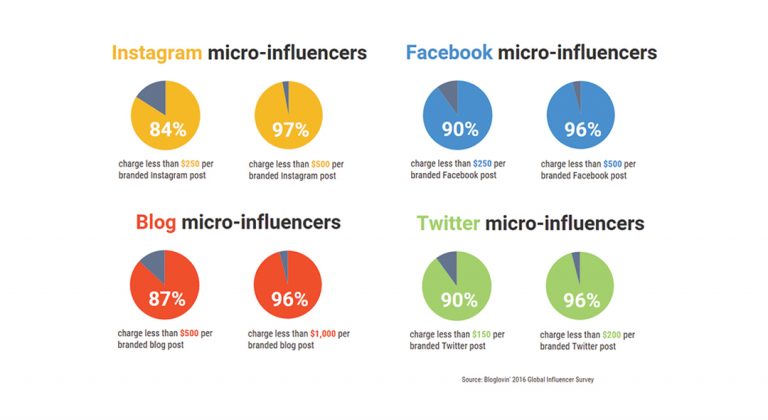
According to Forbes, an account with over a million followers can earn $50k for a single sponsored post (depending on its engagement). “Marketers have noticed that once an account is over a certain size, however, fewer people bother to engage questioning the value of a multimillion army of fans. The ratio of likes and comments to followers peaks when an account has around 1,000 followers. Get more than 100,000 followers, and engagement starts to flatten out; users just aren’t as keen to interact with a celebrity as with someone they can relate to more closely,” wrote The Startup. Moreover, they are commenting that 60 percent higher campaign engagement rates are driven by micro-influencers; those campaigns are 6.7 times more efficient per engagement than influencers with larger followings, which makes them more cost effective; and micro-influencers drive 22.2 times more weekly conversations than the average consumer.
At the same time, according to a study by Dr. Jonah Berger (author of the book Contagious: Why Things Catch On), quoted by HootSuite, 82 percent of consumers were “highly likely” to follow a recommendation made by a micro-influencer. In the study, an unpaid network of American micro-influencers were surveyed about the brand-related conversations they have compared to a group of average consumers.
I believe that all of those indicators, together with the fact that they get bigger engagement and are consider to be trustworthy by consumers, represent enough reasons for brands to start using them even more in their campaigns. If you are a smaller brand or company, or if you have a creative,different and more interesting campaign, or if you have a niche campaign, the micro-influencers are the best solution for you. Micro-influencers are the trend that is here to stay.
Authenticity in marketing versus authenticity in business
“Authenticity is the key component of what makes social media so successful for businesses. Authentic social media is the modern day testimonial: It allows users to interact with businesses in real time, but also creates an open space for conversation and feedback. If a person is having a hard time receiving assistance from a business’s customer service, for instance, all they need to do is tweet at them for a response. Other users can get involved depending on the severity of the situation, forcing all sides to be accountable,” wrote Kelly Samuel for Forbes.
A research shows that 90% of consumers read less than 10 reviews before already forming an opinion about a business. In an age of ever-advancing technology and communication, online reviews remain an important part of consumer research and decision-making. Why? Because they appear to be honest and authentic. We want brands and products in whose statements we can trust.
“There is tremendous power behind authentic and honest messaging. When the story resonates, the audience listens, and when we hear what they are saying and respond with thought, the conversation continues and we all benefit. Brand honesty and authenticity build trust for your content marketing efforts not because you are saying what they want to hear, but because you’re saying what’s real,” wrote expresswriters.com.
Moreover, we think of an authentic company as one that stays true to their core values, principles, and overall brand. Therefore, authenticity is especially important for branding. “If a company decides they want to represent themselves in a way that is different than they normally do, they run the risk of losing the trust of their clients and therefore their integrity and authenticity. Honesty is a quality every company should aspire to have, but not everyone is transparent, which creates a climate of dishonesty,” said elevatemybrand.com.
Marketers must understand that putting brand truth into practice starts with understanding perceptions. Using in-depth research and insights to quantify perceptions and behaviors, will help you know exactly what drives your audience and their interactions with your brand, vastly improving your chances of appealing to the new consumer – who expects nothing less. Using complex data to maintain an audience-centric approach and reach consumers with the right message, in the right place, at the right time. Rather than relying on assumption and a vague understanding of your target audience, the data in existence today is transforming what’s possible by pointing us in what we know to be the right direction.
“Authenticity comes down to giving people a reason to care. Consumers want to care – they want to believe that their purchase is making a difference somewhere, somehow, that the brands they are supporting with their hard-earned dollars are living out the values that they believe in. People respond to honesty, integrity, enthusiasm and love, and they can spot frauds from a mile away. It’s never too late to look for the authenticity that exists within your business and to capitalize on it with thoughtful, engaging campaigns,” explains go.tenthcrowcreative.com.
AdAge.com puts the finger on the reality but offering you the great piece of advice: Don’t say you are authentic — be authentic. “Straight-talking” and “plugged-in” are both better word choices to personify your brand. “Attributes should be sufficiently nuanced to drive differentiation through creative expression in a way that will foster a real audience connection. Skittles is one of my favorite examples. Brand attributes for the company’s “Taste the Rainbow”campaign were unpredictable and irreverent. They provided a clear and genuine brand POV that resulted in fun and crazy — not annoying — creative that engaged its audience while driving brand lift and sales,” concluded Jill Byron.
Net neutrality 2018 – where does it go?
The U.S. Federal Communications Commission voted along party lines on Thursday to repeal landmark 2015 rules aimed at ensuring a free and open internet, setting up a court fight over a move that could recast the digital landscape, reported Reuters.
“The approval of FCC Chairman Ajit Pai’s proposal in a 3-2 vote marked a victory for internet service providers such as AT&T Inc, Comcast Corp and Verizon Communications Inc and hands them power over what content consumers can access. It also is the biggest win for Pai in his sweeping effort to undo many telecommunications regulations since taking over at the agency in January. Democrats, Hollywood and companies such as Google parent Alphabet Inc and Facebook Inc had urged Pai, a Republican appointed by U.S. President Donald Trump, to keep the Obama-era rules barring service providers from blocking, slowing access to or charging more for certain content. The new rules give internet service providers sweeping powers to change how consumers access the internet but must have new transparency requirements that will require them to disclose any changes to consumers,” commented David Shepardon for Reuters.
What can this mean in the near future? Even the consumers will probably don’t see immediate changes, it is reported that smaller startups worry the lack of restrictions could drive up costs or lead to their content being blocked.
This vote will negatively impact small- and medium-sized Internet business, and has the potential to decrease jobs and economic growth system-wide,” said Christian Dawson, executive director of i2Coalition, which includes Amazon and Google, quoted by USA Today.
“The scrapping of the Obama administration’s rules is likely to set up a court battle and could redraw the digital landscape, with internet service providers possibly revising how Americans view online content. The providers could use new authority to limit or slow some websites or offer “fast lanes” for certain content. Republicans on the FCC have sought to reassure young people that their ability to access the internet will not change after the rules take effect. People who favor the move argue that after users realize that little or nothing has changed in their internet access, it will not resonate as a political issue,” writes Fortune.
Meanwhile, in Europe….
According to Conversation, in the UK, “net neutrality is currently protected by EU policy 2015-2120 in support of a Digital Single Market – Brexit fallout aside. Potentially, after Brexit, the UK government could choose to revoke this policy, although this is unlikely because it has already committed to a Universal Service Obligation (USO), effectively making broadband access a legal requirement, as it has been in Finland for many years. Additionally, ISPs are held to account by the UK communications regulator OFCOM, which is tasked with ensuring fair play and protecting consumers from poor service. There has been widespread criticism that OFCOM has been slow and ineffective in persuading big players such as BT/Openreach to act responsibly in the past, though it has made progress recently.”

